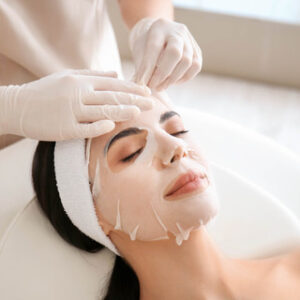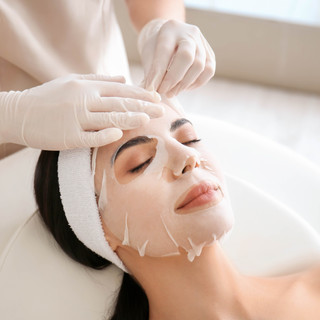Facials are the perfect way to detoxify, pamper, and perk up tired skin. They regulate blood flow, give the complexion a healthy glow, and reduce puffiness and dark spots.
Trained facialists can also safely perform extractions of blackheads (open pores clogged with oil and dead skin) and whiteheads. This is much safer than trying to pop them at home.
A facial scrub is a key step in the process of exfoliating your skin. Exfoliation removes dead skin cells from your face, which helps to brighten your complexion and improve the look of your skin. It also helps to prevent pore clogging, which can lead to blackheads and whiteheads. In addition, exfoliating can help to fade acne scars and increase the effectiveness of your daily skincare regimen by allowing products to penetrate deeper into the skin.
There are two main types of exfoliation: mechanical and chemical. Mechanical exfoliation uses tools to physically remove the dead skin cells from your face, while chemical exfoliation uses chemicals to dissolve and remove the dead skin cells. Chemical exfoliants typically contain alpha hydroxy acids (glycolic acid, lactic acid, mandelic acid, and tartaric acid), beta hydroxy acids (salicylic acid), polyhydroxy acids, or enzymes (trypsin or collagenase).
During a facial, your esthetician will use either a mechanical tool or a chemical product to remove the build-up of dead skin cells from your face. After exfoliating, the esthetician will apply a toner to restore your skin’s natural pH and prepare it for hydration. She will then apply a moisturizer that is suited to your skin type and needs. Moisturizers hydrate your skin and are essential to keeping it hydrated, regardless of your skin type.
Regular exfoliation also helps to eliminate existing blemishes by unclogging pores and reducing the amount of oil that is produced. It also prevents future breakouts by regulating your skin’s sebum production and improving skin texture, which can reduce the appearance of pores.
Although a basic facial can improve your skin, it isn’t able to treat severe skin concerns, such as wrinkles and hyperpigmentation. These issues require more intensive treatments, such as chemical peels or microdermabrasion.
The next time you schedule a facial, consider asking your aesthetician about any specific exfoliation treatment that can target your specific skin needs. By addressing your specific concerns, you can achieve the clear and radiant complexion that you desire! Schedule a facial today to get started on the path to glowing, healthy-looking skin.
Detoxification
A facial removes dirt and oil build-up on your skin, as well as unwanted toxins from everyday life. This helps to keep your skin softer and smoother and prevents acne from forming. It also helps to unclog pores and make blackheads and whiteheads less noticeable. It can also improve the effectiveness of other skin care products, such as serums and moisturizers.
Cleansing: Thoroughly cleansing the skin removes excess oil and dirt, which can clog pores. The facial therapist will use a cleanser appropriate for your skin type and condition.
Exfoliation: A facial scrub or chemical exfoliant can remove dead skin cells and unclog pores, resulting in clearer complexion. Depending on your skin type and needs, this may be done with physical exfoliants like a face scrub or chemical exfoliants such as retinol and alpha hydroxy acids (AHAs and BHAs).
Detoxification Mask: Using a detoxifying mask that contains ingredients like activated charcoal, clay, or natural extracts can help to absorb impurities from the complexion. The mask can be left on the face for a recommended amount of time to achieve maximum benefits.
Tone: Using a toner that is suitable for your skin type can balance and soothe the skin after the mask has been removed. It can also help to protect the skin’s barrier function and hydrate it.
Hydration: Applying a light moisturizer can hydrate the skin, ensuring that it isn’t dry or itchy during the detoxification process. Moisturizers that contain hyaluronic acid can help your skin retain moisture, resulting in healthier-looking skin.
Sensitivity or Redness: During the detoxification process, your skin might feel more sensitive or itchy than usual. This is normal and should resolve itself as your skin adjusts to the new routine.
To ensure that your skin stays healthy and happy during the detoxification process, it is important to have a balanced diet, proper hydration, and regular exercise. This will not only help your skin, but it will also help you to reduce stress and maintain a positive attitude.
Rejuvenation
The goal of rejuvenation is to improve the skin, and a facial will help if you have blemishes or wrinkles. You will need to follow a daily skin care program in order for the results of your facial to last.
Basic facials cannot treat severe wrinkles or hyperpigmentation, which require more intensive solutions such as chemical peels and microdermabrasions. However, they can help smooth out fine lines and wrinkles and brighten the complexion.
This treatment uses a combination of ingredients that work together to lift, tone and boost collagen production in the skin for a younger appearance. This is a popular anti-aging facial that uses Padina pavonica marine algae, precious quartz minerals, and massage techniques such as effleurage to leave the skin feeling refreshed and rejuvenated.
Depending on the type of rejuvenation facial, your client may need to wait a few days or weeks before they can see visible results. This is because it takes time for the body to produce more natural collagen and heal itself after a rejuvenation treatment. It is important to take good care of your skin after a facial and use high-quality products that are suitable for your skin type.
A rejuvenation facial will usually include a deep cleanse followed by exfoliation. This is to remove any dirt and oil build-up that could cause skin problems such as acne. The facial also includes an enzyme peel and acid treatment to remove dead skin cells. Afterwards, a face mask is applied to the skin. This will depend on the type of facial you have booked but will usually include a clay mask or an alpha hydroxyl (AHA) acid mask.
A facial will help your skin look fresher and healthier, which will also make you feel more confident about your appearance. The results from a facial will last longer if you follow a proper skincare regimen that includes cleansing, moisturizing and exfoliating the skin on a daily basis. It is also important to protect your skin from the sun by using a high-quality sunscreen when going outside.
Anti-aging
Even people with healthy skin can benefit from facials, which help to hydrate and plump the complexion. In addition, they can decrease the appearance of fine lines and wrinkles and clogged pores. The skin is also protected for the long haul by reducing free-radical damage.
In addition to the basic cleansing, exfoliation and mask application, a facial can include massage and specific treatment options. These can include LED light therapy or a hydrofacial.
A traditional facial begins with a thorough consultation. The esthetician will ask about the medications and supplements you are taking, your skin concerns and your skin care routine. This helps them choose the right products for your facial needs.
Steam is often included in a facial because it helps to open the pores and soften any blackheads or whiteheads for extraction. This is a very important step. It should only be done by a licensed esthetician.
Exfoliation is also an essential part of a facial, and it can be done using either a mechanical or chemical exfoliant. Mechanical exfoliants have a rough texture that rubs off the top layer of dead skin cells. Chemical exfoliants use enzymes and acids to loosen the bond between skin cells and break them up.
After the exfoliation step, a facial mask is usually applied to help moisturize the skin and provide additional benefits such as antioxidant protection or anti-aging benefits. Depending on the mask, it may be used to address acne, reduce fine lines and wrinkles, boost collagen production or reduce hyperpigmentation.
Facials can also address specific skin conditions by including add-on treatments such as microdermabrasion, chemical peels or a hydrafacial. Some facials even target skin tone by using ingredients such as licorice extract to reduce redness and vitamin C to brighten the complexion.
Once you’ve experienced the benefits of a facial, it’s best to maintain the results by getting one on a regular basis. Just like you would wash your hair on a regular basis, it’s a good idea to get a facial once or twice a month. This will keep your complexion looking healthy and vibrant!
